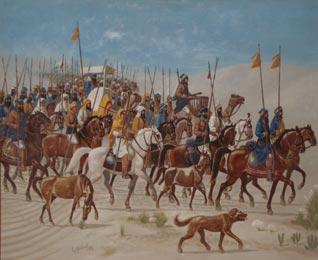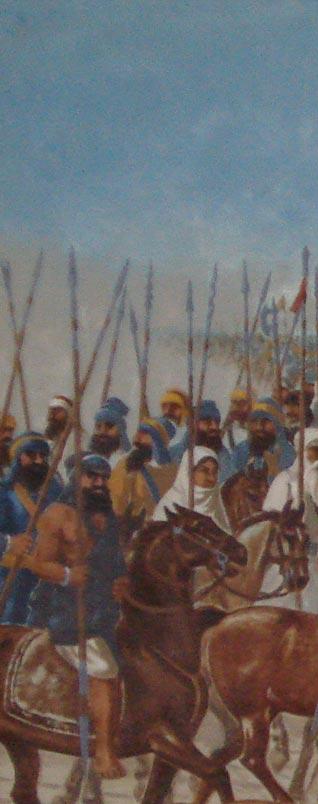
All images: details from an oil painting ("The Buddha Dal") by the late Kirpal Singh (1977). Copyright: The Ishar Singh Mahinder Kaur Foundation.



History
The Original Homeland Security:
The Buddha Dal
NIHANGSINGH.ORG
The lineage of the Budha Dal traces back to the creation of the Akal Army at the time of Guru Hargobind, The Sixth Master.
Baba Budha Ji is considered one of the foremost figures in Sikh history - he was one of Guru Nanak's closest disciples and served the first six Sikh Gurus.
When Baba Buddha arrived at Gwallior fort, accompanied by
Sikh warriors on horseback to greet Guru
Hargobind, the latter was greatly pleased and granted the following boon:
"Baba Buddha ji, you have performed a great service to the Guru's
house. You shall forever be remembered in the world, in your name will
run the supreme Khalsa army."
When Guru Gobind Singh sent the Khalsa Panth with Baba Banda Singh Bahadar to Punjab form Nander, Baba Binod Singh was elected as the Jathedar of the Dal Khalsa army.
Baba Binod Singh was of the seventh generation of Guru Angad's family (the Second Master), and had actively served the Tenth Master. When differences arose between the Nihang Singhs loyal to Guru Gobind Singh and those Sikhs loyal to Baba Banda Singh, the Nihang Singhs lead by Baba Binod Singh departed company with the others in order to keep alive the true traditions of the Khalsa.
They became known as the Tat (true) Khalsa whereas the group loyal to Banda Singh were known as the Bandai Khalsa.
With the martyrdom of Baba Banda Singh Bahadar, the
Khalsa was soon united again. After Baba Binod Singh, the humble and
wise Baba Darbara Singh lead the Khalsa Panth. It was when Nawab Kapoor
Singh assumed leadership of the Khalsa that the lineage of the Sikhs who
actively served the Gurus were formally institutionalised as the Buddha
Dal. Giani Sulakhan Singh comments on this process which took place in
1773:
"The senior Singhs such as Baba Kapoor Singh, Baba Deep Singh and
Baba Kahan Singh held a gurmatta (meeting) in which they decided that
the Khalsa be split up into separate battalions. They considered the
boon given by Guru Hargobind and therefore decided naming the
supreme body of the Khalsa Panth as the Buddha Dal, in the auspicious memory of Baba Buddha ji."
It is noteworthy that the Buddha Dal still retains the original Nishan
Sahib (battle standards) from some of these key historical events as a
sign of their continuous Guru-ordained lineage. These include a Nishan
Sahib from Baba Buddha's trip to Gwallior and the Buddha Dal Nishan
sahib from the period of NaWab Kapur Singh.
Baba Prem Singh Hoti highlights the historic functions of the Buddha Dal:
‘The Buddha Dal's responsibilities were to look after and preserve all
the gurdwaras, to spread the preaching of the Khalsa Dharam, to
emphasise the importance of receiving the Nectar of the Sword (Amrit)
and to preserve the purity of the true traditions of the Guru,
protecting them from perversion by maintaining their original form. When
need be they were to fight alongside the Tarna Dal and wield their swords in battle.'
In the mid-eighteenth century, the Mughals had placed a price on the head of each Sikh, dead or alive, which led to the two Holocausts (Ghallugharas). The Sikh population, consequently decimated, thus became - for several decades - a roving army.
During this period, the Buddha Dal served as the fifth mobile throne (Panjvaanh Takht) of the Sikhs. (The Akaal Takht, Patna Sahib, Kesgarh Sahib and Hazoor Sahib were then the four stationary Takhts). For their maintenance was the Chalda Vaheer - moving encampment - which would spend its time moving from one historical shrine to another, ensuring that those appointed to do so were properly performing their duties at their entrusted gurdwaras.
Even
today, the Buddha Dal consists of a stationary unit and a Chalda Vaheer which
roams around the country, spreading the message of the Sikh faith and visiting
the historic shrines of the Guru, many of which still remain under the
supervision of the Buddha Dal.
The supreme leadership of the Buddha Dal was evident at the time
of Akali Phula Singh who, even during the reign of Maharaja Ranjit Singh, exercised complete authority in matters concerning
the Sikh religion. His order to have the Emperor - Ranjit Singh himself - punished with lashings for his violation of the Sikh tenets is a
firm confirmation of this fact.
Many European observers of the time have also commented
on the supreme authority of the Nihang Singhs:
‘Their (the Sikhs) government is, in theory, a theocracy. The
General Council, which meets on public emergencies, is thought to be
actuated by the immediate inspiration of the Deity (One God, Lord of All). A class of devotees,
called Acali, who are the priests of the nation, have, by their
boldness and union, aided by the superstition of the people, acquired a
great ascendancy in the government. These men summon the General
Council.' ( The Missionary Register, 1814, vol. 2, p.115)
It is because of its position of authority, the term Shiromani (highest
of all) is applied to the Buddha Dal.
In recent times, this term has been widely associated with the Shiromani Gurdwara Parbandak Commmitte (S.G.P.C.) which was entrusted during the 1920s, during British rule in Punjab, to manage the responsibilities of the various gurdwaras.
September 29, 2010


